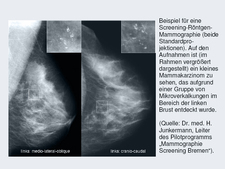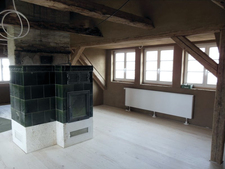-
Topics
subnavigation
Topics
Electromagnetic fields
- What are electromagnetic fields?
- Static and low-frequency fields
- Radiation protection relating to the expansion of the national grid
- High-frequency fields
- Radiation protection in mobile communication
Optical radiation
Ionising radiation
- What is ionising radiation?
- Radioactivity in the environment
- Applications in medicine
- Applications in daily life and in technology
- Effects
- What are the effects of radiation?
- Effects of selected radioactive materials
- Consequences of a radiation accident
- Cancer and leukaemia
- Genetic radiation effects
- Individual radiosensitivity
- Epidemiology of radiation-induced diseases
- Ionising radiation: positive effects?
- Risk estimation and assessment
- Radiation protection
- Nuclear accident management
- Service offers
-
The BfS
subnavigation
The BfS
- About us
- Science and research
- Laws and regulations
- BfS Topics in the Bundestag
- Links
The Radiation Protection Act
New basis for radiation protection and work of the BfS

Comprehensive protection against harmful radiation in medicine, protection against radon in dwellings and better provisions for an emergency – these are the central areas of the new Radiation Protection Act which was adopted on 12 May 2017. The reorganisation reflects the increasing significance of radiation protection in many areas of life: The Act creates clear structures and represents the current state of science. Thus, it also creates a new basis for radiation protection and the work of the Federal Office for Radiation Protection (BfS).
New competencies for the BfS
The BfS gains numerous new competencies, for example in the evaluation of new medical procedures. Thus, also the role of the BfS as an authority established for the protection of patients is strengthened. This shows also in numerous regulations which the BfS had already strongly promoted in the past. These regulations include provisions on the naturally occurring rare gas radon, on the radioactivity contained in building materials, and on the justification of new medical applications. In emergency preparedness, the BfS gains importance, too: Responsibilities will be combined and measures to protect the population will be better co-ordinated.
Apart from general regulations, the Act comprises four main parts:
Radiation protection in planned exposure situations
One crucial area is
"Radiation protection in planned exposure situations"
, which includes regulations for the early recognition of diseases by means of radiological procedures and an information and reporting system in the event of incidents in the medical field.Radiation protection in emergency exposure situations
Rules for emergency preparedness and the establishment of a radiological situation centre, for whose operational implementation the BfS will be essentially responsible, can be found in the part
"Radiation protection in emergency exposure situations"
.Radiation protection in existing exposure situations
Provisions for the handling of radon and rules on radioactive relics and radioactivity in building products are regulated in the part
"Radiation protection in existing exposure situations"
.Exposure overlapping provisions
The part "Exposure overlapping provisions" summarises, among others, provisions for the Radiation Protection Register, to help better protect occupationally exposed persons.
Act implements EU Directive into national law
The reorganisation is based on an EU Directive and summarises provisions from the Radiation Protection Ordinance, the X-Ray Ordinance, and The Precautionary Radiation Protection Act. The emergency preparedness provisions will already become effective in 2017, three months after the Radiation Protection Act has been announced. With regard to the other new regulations, new ordinances substantiating the legal provisions will be developed, the major part of which until the end of 2018. The BfS as the specialist radiation protection authority is closely involved in this drafting process.
Valuation method justificationshow / hide
New methods in which man and environment may be exposed to radiation, will have to pass through the valuation method of justification in future. This applies to medical applications of ionising radiation e.g. in medical diagnostics, but also to the use of radioactive substances in consumer goods such as luminous numerals in watches and clocks. Their economic, societal, or other benefit is to be weighed against a health impairment that might entail.
Within twelve months, the Federal Office for Radiation Protection will examine whether the benefit outweighs the risk and whether the same benefit could also be achieved with a method not using ionising radiation.
Early diagnosisshow / hide

![]() X-ray mammography image
Source: Dr. med. H. Junkermann
X-ray mammography image
Source: Dr. med. H. Junkermann
In Germany, mammography examination for the early diagnosis of breast cancer in women between age 50 and age 69 is currently the only screening examination for early diagnosis using X-radiation.
According to the new Radiation Protection Act, it will also be possible to approve individual early diagnosis measures in future. These may include, for example, methods and processes for the early diagnosis of lung cancer in smokers, constricted coronary vessels, or intestinal adenoids and colon cancer.
However, high demands are made on justification and implementation: Basically, the diagnostic and therapeutic benefit of patients is paramount.
In future, the Federal Office for Radiation Protection will, therefore, scientifically evaluate early diagnosis examinations as to whether the benefit of such an examination outweighs the risk. Furthermore, the responsible physician must do this balance in each individual case.
Reporting system for the protection of patientsshow / hide

On account of the increasing application of ionising radiation and radioactive substances in medicine, not only the radiation exposure of the population does increase but, at the same time, the risk of faulty irradiations and accidents. For example, as a result of technical defects or human failure, cancer patients may accidentally receive too high a dose when being irradiated, which again may lead to severe side effects.
Up until now, such incidents have only been registered partially in Germany, since there is no obligation to report them. However, in order to be able to learn lessons for the future from these cases, the new Radiation Protection Act provides for a central reporting system of such significant occurrences in the medical field. Reports about faulty irradiations and accidents are to be collected, evaluated, and passed on to other users.
The objective is to recognise dangers in advance and, if necessary, to initiate countermeasures at an early stage.
Emergency managementshow / hide

![]() BfS emergency preparedness centre
BfS emergency preparedness centre
In the event of an emergency situation in Germany or abroad where large amounts of radioactive substances are released into the environment, the federal and Länder authorities and organisations should co-ordinate their safeguards more closely in future.
The new Radiation Protection Act therefore provides for emergency plans that have been co-ordinated between federation and Länder and are based on so-called reference scenarios. These cover both nuclear power plant accidents and events with more regional impacts, such as transport accidents.
Furthermore, it is planned to establish a radiological situation centre which will be established by the Federal Ministry for the Environment, Nature Conservation and Nuclear Safety and for whose operational implementation the BfS will be essentially responsible. In the event of an emergency, this situation centre will make an analysis of the situation, which will be valid Germany-wide, describing the current situation and the assumed future development and proposing recommendations for protection measures.
Up until now, the Länder (for disaster control purposes) and the federation (for supra-regional radiation protection measures) had to develop own overviews of the situation.
Radonshow / hide

![]() Radon paths from the ground into buildings
Radon paths from the ground into buildings
Radon is a natural, radioactive rare gas escaping from the ground, which may accumulate in buildings. Apart from smoking, inhaling radon is among the greatest risks to develop lung cancer.
With the new Radiation Protection Act, clear measures to minimise radon have now been introduced for the first time. For example, a reference value has been determined for the evaluation of the radon concentration in living spaces. According to the principle of minimisation of radiation protection, the radon concentration should neither exceed nor fall below this value, if possible. For this purpose, precautions should be taken to prevent the radon from getting into interior rooms or at least to make it harder. What measures need to be taken is explained in a catalogue of measures which is updated on a regular basis.
Furthermore, areas in Germany are determined where a high radon concentration in buildings is to be expected. In these areas, special measures for radon-safe building need to be observed.
In particular the protection against radon at workplaces is strengthened by the new Act. Previous protection provisions only applied to certain workplaces, for example in mines or caves. According to the new Radiation Protection Act, all workplaces in storeys near the ground level of buildings in areas with high radon concentrations are subject to the provisions for the protection against radon at workplaces.
Radioactivity in building materialsshow / hide
Certain building materials contain enhanced concentrations of natural radionuclides. This may be caused by natural raw materials or additives of residues from industrial processes in which natural radioactive substances accumulate. They are partly used as secondary raw material in building.
So far, there has been no binding legal basis for the radiological evaluation of building materials. This will change with the new Radiation Protection Act: Measurements will be obligatory for certain, possibly radiologically relevant building materials.
This way, it will be examined whether the reference value of 1 millisievert per year can be exceeded by the radionuclides contained in the respective building materials. In that case, the responsible authorities must be informed. The authorities can then initiate protection measures, e.g. restriction to certain applications.
Management of radioactive relicsshow / hide
The new Radiation Protection Act contains regulations for the management of radioactive relics. So far, the legislative regulation for the remediation of radiological relics consisted of two parts:
- In the new federal states, GDR law was still effective,
- In the old federal states no special radiation protection provisions existed for this area; therefore the Federal Soil Protection Act was applied.
The new Radiation Protection Act contains for the first time a uniform definition of "relics" in conjunction with enhanced radioactivity: Relics are defined as contaminations from completed human activities if the reference value of the effective dose of 1 millisievert per year is exceeded. This may refer to contaminated plots, parts of plots, buildings, or bodies of water. Where there are indications for a radioactive relic, they must be reported to the responsible authority. The authority then decides as to whether or, respectively, which measures need to be taken.
The measures shall be guided by experiences gained, among others, in the decommissioning and remediation of uranium mining and their radioactive relics in the former GDR.
Radiation Protection Registershow / hide

In the Radiation Protection Register operated by the Federal Office for Radiation Protection, data of persons occupationally exposed to radiation is compiled and evaluated. This includes
- medical personnel,
- employees of nuclear installations,
- pilots and flight attendants, but also
- persons occupied in mines or waterworks.
The Register goes back to the 1990s and currently comprises data concerning about 400,000 persons whose radiation exposure is monitored. Their radiation protection relevant data is recorded to be able to guarantee completely at all times the safety of persons handling ionising radiation, also if they change workplaces.
The new Radiation Protection Act, therefore, provides for the introduction of clear personal identifiers which also remain unchanged in the event of a change of name or employer.
State of 2017.05.11


